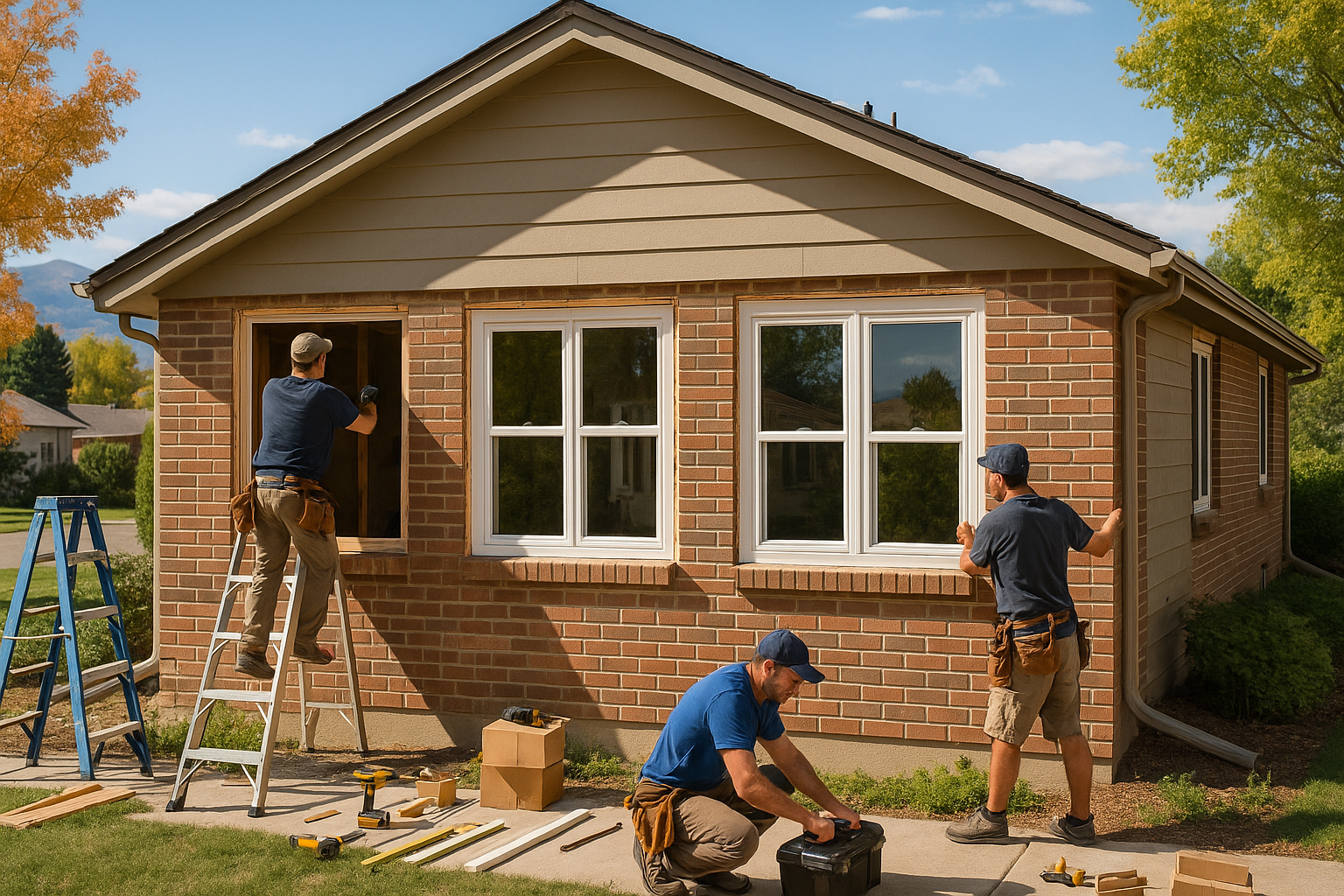The best window replacement timeline in Colorado runs from April through October, with peak installation seasons in late spring (May-June) and early fall (September-October) when weather conditions are most favorable and contractor availability is optimal for efficient project completion.
According to the Colorado Contractors Association, projects scheduled during optimal weather windows experience 40-60% fewer weather delays and completion issues compared to off-season installations, making timing a critical factor for both cost control and project success in the state's variable climate.
Colorado's unique climate presents distinct challenges and opportunities for window replacement projects. From sudden spring snowstorms to intense summer hail and early winter freezes, understanding seasonal weather patterns is essential for successful project planning. Proper timing ensures not only smooth installation processes but also optimal pricing, contractor availability, and long-term window performance in the state's demanding environment.
Understanding Colorado's Climate Patterns
Seasonal Weather Windows and Installation Conditions
Colorado's installation season typically begins in mid-to-late April when consistent freezing temperatures subside and extends through October before winter weather returns. Spring installations benefit from mild temperatures and lower humidity, creating ideal conditions for sealant curing and material handling.
Summer months offer the longest daylight hours and most predictable weather patterns, though afternoon thunderstorms and occasional hail require flexible scheduling. Fall provides excellent installation conditions with stable temperatures and low precipitation, making it many contractors' preferred season for complex projects.
Regional Variations Across Colorado
Denver metro area enjoys the longest installation season, typically running from early April through late October due to lower elevation and urban heat island effects. Mountain communities face shorter windows, often limited to May through September, with higher elevation areas potentially restricted to June through August.
Front Range communities like Colorado Springs and Fort Collins fall between these extremes, with installation seasons running April through October but requiring more weather contingency planning. Eastern Plains areas may extend seasons slightly due to less severe winter conditions but face challenges from high winds and severe storms.
Optimal Timing for Different Project Types
Single Window vs. Whole-House Replacements
Single window replacements can often be completed in one day, making them feasible during brief weather windows throughout the installation season. These smaller projects have flexibility to work around short-term weather events and can often be rescheduled with minimal disruption.
Whole-house window replacement projects require 2-5 consecutive days of favorable weather, making timing more critical. These larger projects benefit from scheduling during Colorado's most stable weather periods in late spring and early fall when multi-day weather patterns are more predictable.
Emergency Replacements vs. Planned Projects
Emergency window replacements due to storm damage or security issues cannot wait for optimal timing and may require temporary protective measures during installation. Contractors experienced with Colorado weather can perform emergency work safely during challenging conditions using specialized techniques and materials.
Planned replacement projects offer the luxury of optimal timing selection, allowing homeowners to target the best weather windows and potentially capture seasonal pricing advantages. Advanced planning also ensures better contractor availability and material procurement during peak demand periods.
Monthly Timeline Breakdown for Colorado
Spring Installation Window (April-June)
April marks the beginning of Colorado's installation season, though weather remains variable with potential late-season snow events. Early April projects require flexible scheduling and weather contingency plans, while late April generally offers more stable conditions for consistent project progression.
May and June represent prime installation months with mild temperatures, lower precipitation, and excellent working conditions. Contractor availability is good, and material delivery is reliable. However, this period sees increasing demand, so early booking is essential for preferred scheduling.
Summer Peak Season (July-August)
July and August offer the most consistent weather conditions with minimal precipitation and stable temperatures ideal for window installation. Long daylight hours allow for extended work periods, and material performance is optimal during warm, dry conditions.
Summer represents peak demand season with highest contractor utilization and potential premium pricing. Afternoon thunderstorms require scheduling flexibility, but these brief events rarely cause significant project delays when properly managed by experienced contractors.
Weather Delay Management and Contingency Planning
Preparing for Colorado's Unpredictable Weather
Successful Colorado window replacement projects include comprehensive weather contingency planning with flexible scheduling and temporary protection protocols. Contractors should provide weatherization materials and techniques to protect homes during unexpected weather events.
Project timelines must account for Colorado's rapid weather changes, including sudden temperature drops, afternoon storms, and occasional severe weather events. Building 20-30% schedule buffer time helps accommodate weather delays without compromising project quality or rushing installation procedures.
Protective Measures During Installation
Professional contractors use temporary weatherization techniques including plastic sheeting, plywood covers, and rapid-deployment protection systems to secure openings during weather events. These measures protect both the home interior and allow work to continue safely during brief weather interruptions.
Quality installation requires specific temperature and humidity ranges for optimal sealant performance and material handling. Contractors experienced with Colorado conditions understand when to pause work and when conditions allow safe continuation with appropriate protective measures.
Contractor Availability and Seasonal Demand
Peak Season Scheduling Challenges
Colorado's compressed installation season creates intense demand for qualified contractors during optimal weather windows. Homeowners planning projects should book 6-8 weeks in advance during peak season (May through September) to secure preferred timing and contractor selection.
Premium contractors often book entire seasons in advance, making early planning essential for accessing the best installation teams. Waiting until peak season to schedule projects may result in limited contractor options or delayed installation timing until less favorable weather periods.
When planning your window replacement timeline, understanding the cost implications of different scheduling choices can help optimize both timing and budget. For comprehensive information about how timing affects window replacement costs and project planning, explore our detailed guide: 🔗Fiberglass Window Cost in Colorado: Complete Pricing Guide & Installation Factors
Off-Season Opportunities and Limitations
Late fall and early spring offer potential cost savings and better contractor availability, but require accepting increased weather risk and potential project delays. Some contractors offer off-season pricing incentives to maintain consistent work flow throughout the year.
Winter window replacement is generally limited to emergency situations due to extreme weather conditions and material performance limitations. However, planning and ordering during winter months positions projects for early spring installation when favorable weather returns.
People Also Ask About Window Replacement Timeline in Colorado
1. What is the best month to replace windows in Colorado?
May and September are typically the best months for window replacement in Colorado, offering optimal weather conditions with minimal precipitation and stable temperatures. May provides mild spring conditions ideal for installation, while September offers stable fall weather before winter arrives.
These months balance favorable weather with reasonable contractor availability and pricing. May sees increasing demand as homeowners emerge from winter, while September represents the final push before the installation season ends, creating urgency that can sometimes lead to better pricing negotiations.
Avoid July and August if possible, as these peak summer months see highest demand, premium pricing, and afternoon thunderstorm risks. However, if your timeline requires summer installation, these months offer the most predictable weather once you account for daily storm patterns.
2. How long does window replacement take in Colorado homes?
Single window replacement typically takes 2-4 hours per window for standard installations, while whole-house projects require 2-5 days depending on home size and window complexity. Colorado's weather can extend timelines, so professional contractors build weather contingency time into project schedules.
Custom or specialty windows may require longer installation times, particularly for large picture windows or complex architectural features common in Colorado homes. Mountain area installations often take longer due to challenging access conditions and weather precautions.
Emergency replacements can often be completed within 24-48 hours during favorable weather, but may require temporary weatherization measures if conditions are challenging. Professional contractors prioritize securing the home quickly, then completing finish work when conditions improve.
3. Can windows be replaced in winter in Colorado?
Winter window replacement is possible but challenging due to extreme temperatures, snow conditions, and material performance limitations. Most contractors limit winter work to emergency situations involving security risks or severe damage that cannot wait for spring weather.
Successful winter installations require specialized techniques including heated work areas, modified sealants rated for low temperatures, and extensive temporary weatherization measures. These requirements significantly increase project costs and complexity compared to standard season installations.
If winter replacement is necessary, work with contractors experienced in cold-weather installation techniques. They understand material limitations, proper curing procedures, and protective measures necessary to ensure long-term window performance despite challenging installation conditions.
4. How far in advance should I schedule window replacement in Colorado?
Schedule window replacement 6-8 weeks in advance during peak season (May through September) to ensure preferred timing and contractor selection. Popular contractors often book their entire season by early spring, making advance planning essential for optimal scheduling.
For off-season installations in late fall or early spring, 3-4 weeks advance notice is typically sufficient due to lower demand. However, weather windows can be unpredictable during these periods, so flexibility in scheduling becomes more important than specific date preferences.
Emergency replacements obviously cannot be scheduled in advance, but establishing relationships with reliable contractors before emergencies occur ensures faster response when urgent situations arise. Many contractors prioritize existing customers for emergency services.
5. What weather conditions prevent window installation in Colorado?
Window installation should be avoided during precipitation (rain, snow, sleet), high winds over 25 mph, and extreme temperatures below 40°F or above 90°F. These conditions affect material performance, worker safety, and installation quality that could compromise long-term window performance.
Humidity levels above 85% can prevent proper sealant curing, while rapid temperature changes during installation can cause thermal stress in materials. Professional contractors monitor weather conditions continuously and adjust schedules to ensure optimal installation conditions.
Severe weather warnings, including thunderstorm watches, tornado warnings, or winter storm advisories, automatically halt installation work regardless of current conditions. Safety takes precedence, and contractors will secure job sites and resume work when conditions improve and remain stable.

Our Take
At Five Seasons Windows & Doors, we've learned that successful window replacement projects in Colorado depend as much on timing as they do on quality materials and installation expertise. Having completed thousands of installations across the state's diverse climate zones, we understand how critical proper scheduling is for project success and customer satisfaction.
The compressed installation season creates intense demand during optimal weather windows, making early planning essential for securing preferred timing and contractor selection. We typically begin booking spring and summer installations during winter months, allowing homeowners to secure optimal scheduling before peak demand drives up costs and limits availability.
Our experience shows that homeowners who plan projects during shoulder seasons (late spring and early fall) generally achieve the best balance of favorable weather, contractor availability, and competitive pricing. While summer offers the most predictable weather, the premium pricing and scheduling challenges often make spring and fall installations more cost-effective without sacrificing quality or reliability.
Final Takeaway
Planning the best window replacement timeline in Colorado requires balancing optimal weather conditions with contractor availability and project complexity. The state's compressed installation season from April through October demands early planning and flexible scheduling to accommodate Colorado's unpredictable weather patterns.
Success depends on understanding regional climate variations, seasonal demand cycles, and weather contingency planning. Projects scheduled during peak weather windows (May-June and September-October) typically experience fewer delays and complications, while summer installations offer predictable conditions despite premium pricing and high demand.
Working with experienced Colorado contractors who understand local weather patterns and seasonal challenges ensures your project timeline accounts for climate realities while maximizing installation quality. By planning ahead and maintaining scheduling flexibility, you can achieve optimal timing that delivers both cost-effective pricing and reliable project completion regardless of Colorado's weather surprises.
Get Started Today
Five Seasons Windows & Doors is Colorado’s top-rated local window company with 230+ 5-star reviews. We offer expert advice, no-pressure quotes, and flexible project options — including phased installs. Schedule your consult today.




